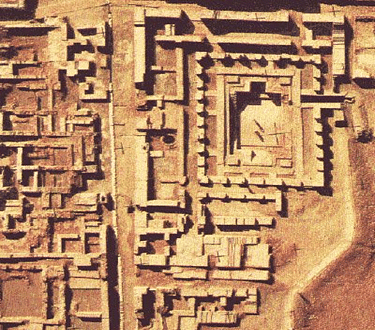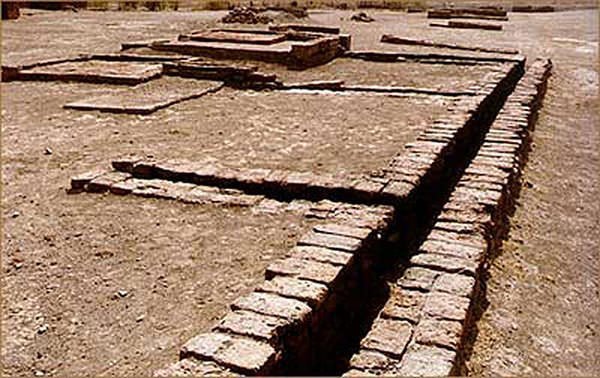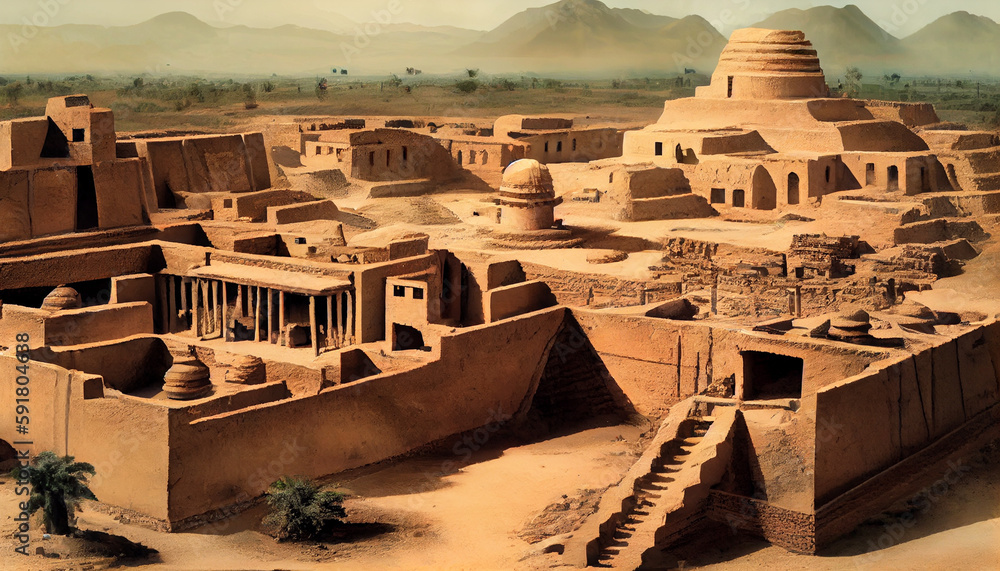Civilization, according to Cambridge English Dictionary: Meanings & Definitions is a human society with its well-developed social organizations or the culture and way of life of a society or country at a particular period in time.
Spread over the regions of India, Pakistan, Afghanistan, etc., is the world’s oldest civilization, the Indus Valley civilization. The civilization existed between a timeline from 3000-1300 BCE, on the bank of the Indus River, and is known to be the world’s first civilization. Due to its modern planning and implementation, it is considered as the first milestone to human urbanization and modernization.
1. World’s first planned city
The cities of Harappa and Mohenjodaro were well-planned with proper drainage systems, double-storeyed, market areas, and other places of public gathering like the great bath, granaries, etc. The city followed a grid pattern with the roads crossing at right angles. Almost all the places excavated are seen as having a similar structure and pattern making it as one of the most sophisticated and non-chaotic societies of all times. The usage of burnt bricks is very prominent in this civilization. The streets were not ‘Katcha’ or of mud but were made up of burnt bricks to allow smooth passage.

The civilization is also home to one of the oldest artificial docks in the world, Lothal.
2. The drainage systems were much more advanced at the time
Located on the banks of the Indus River (Sindhu, also the name from which the word Hindu was derived), the civilization had an advanced system of sanitation, with proper water channels and drainage systems. It took a shock to the historians when they discovered their water management system was advanced to have 2 different channels: one for the wastewater and the other for stormwater! The wastewater drains were also underground and the streets had dustbins for the proper disposal of garbage (brick containers in Mohenjo-Daro).

3. Largest civilization among the 4 ancient civilizations
You must be aware of the fact that the Indus Valley Civilization is the oldest in the world. But did you know that it is also the largest among the 4 ancient civilizations including, the Mesopotamian, Chinese, and Egyptian? Spread over an area of 1,260,000 sq, almost 1050 dead cities are found out of which 96 cities are excavated which include, Harappa, Mohenjo-Daro, Dholavira, and Rakhigarhi.


When we talk of the population, the estimated population was somewhat about 5 million. Despite of the huge population, the civilization was one of the most sophisticated ones with no chaos.
4. A sophisticated society
Whether it be the bronze statue of the dancing girl, the priest-king figure or the seal of Pashupati, the people of the Indus Valley Civilization had a knack for crafts making. The bricks of this time attracted the better attention of the historians as they were burnt The pottery of this time includes wheel-thrown and handmade pieces as well. The Harappans excelled in bead making and jewelry making (of metals, stones, and beads) and were fine weavers. The materials excavated suggest they wore linen and cotton fabric and used natural dyes to dye their clothes.

The society was a sophisticated one with all kinds of urbane concepts.
These crafted materials were used in their day-to-day life. The people of the Indus Valley Civilization believed in the afterlife as they used to bury the dead with these materials of daily use.
5. They had a Dentist!
With all that drilling and filling you might think that dentistry is a modern job. However, you will be amazed to know that dentistry is one of the oldest professions in the world.
Equipment for tooth drilling and nine teeth have been excavated from the Mehargarh site (Indus Valley city) in Baluchistan. The nine teeth have been identified of different genders and no particular class, showcasing that dentistry was open to all genders and classes in the civilization.

The drills in the teeth (about 9000 years old) are believed to be done to eradicate cavities. The Indus Valley Civilization has evidence of dentistry being practiced as far back as 9000 years.
6. The houses were 2-storeyed!
While most houses in the villages are still made up of mud, straws, and limestone, the houses in the Indus Valley were made up of burnt bricks. Yes! Burnt bricks. The remnants of the civilization depict that the houses had a build-up of up to 2 storeys. The most important cities of the Indus Valley civilization Harappa and Mohenjo-Daro had these kinds of houses, a rarity at that time, shows the fineness of the craftsmen of the era.
7. The houses had attached bathrooms with flush toilets
Remnants of the civilization suggest that the houses had flush toilets! The people were well aware of sanitation and maintained proper hygiene. The pieces of evidence yielded by the Harappa site suggest that these private toilets were built of bricks and were positioned over a drainage system to help maintain sanitation. The drainage system being underground helped carry the water waste without affecting the sanitation of the residents.

The water in the toilets were supplied from wells or other river bodies. The flush system was a simple one which cleared out the waste with the help of gravity.
8. They worshipped Lord Shiva!
One of the most complicated designs out of the thousands of seals found was ‘The Seal of Pashupati.’ Excavated from the Mohenjo-Daro site, the seal depicts a yogi sitting in a meditating position with animals like elephant, tiger, buffalo, and Indian rhinoceros carved out on it.
Pashupati, which literally means the Lord of animals, is believed to be the earliest depiction of the Hindu deity Shiva. The depiction of animals also signifies their beliefs and practices related to nature and animals.
9. Great baths, granaries, and other architectures
Every city in the Indus Valley Civilization had its Great bath, granaries, citadels, burial grounds, and public gathering platforms. The granaries were huge in size and had air passages to remove any moisture to keep the grains dry. This kind of advanced granaries was found only after about 3000 years in Roman brick granaries.
The historians believed that like in most of the ancient cultures, the presence of large baths was associated with spiritual purification and religious purposes. The great bath is believed to be designed for the same purpose as well. With its grand structure and its ability to accommodate a larger population, we can predict that the use of the Great Bath was not limited to the upper-class hierarchy only.

The evidence also shows that the burial grounds were separated from the residential area in the Harappan civilization. The dead were buried with goods and other essentials, depending on their age, gender, and status for the afterlife.
10. The Indus Script is yet to be deciphered
Even after several long attempts the Indus Valley script is not yet deciphered. The script has symbols varying from 400 to 700 in number and the linguists are unsure if these symbols are alphabets or syllables or none.

The script appears to have many different symbols, and their exact meanings and grammatical functions are unclear. The language spoken in the Indus Valley is also unknown to mankind making it more difficult for the script to be deciphered!
CONCLUSION
Less than 10 percent of the known Indus Valley sites over 1,260,000 sq miles in northwest India and Pakistan have been excavated, leaving a lot of facts in the ruins to be discovered. The deciphering of the script will also provide a fine lead to unravel the mysteries of this civilization. This ancient civilization with sophisticated urban planning, fine craftsmen, and an undeciphered script holds a lot to itself. Its approach to achieving a better urban life only made it way ahead of its time.
Follow our blog ItihaasKiKhoj – for more such content

